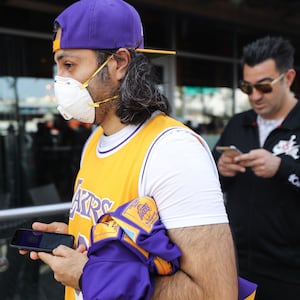As U.S. officials worked to shatter international records by sending a vaccine for the new, deadly coronavirus to phase one clinical trials, they also urged Americans to prepare for the worst.
Meanwhile, experts poked new holes in the federal response so far to an illness that appeared to be on the cusp of a major national outbreak.
There were 57 total confirmed cases of the 2019 novel coronavirus in the United States at last count on Tuesday morning, according to Nancy Messonnier, director of the National Center for Immunization and Respiratory Diseases at the Centers for Disease Control and Prevention. That tally included 14 patients picked up through the American health system and 43 more repatriated to the United States from the Diamond Princess cruise ship or State Department-chartered flights.
ADVERTISEMENT
Messonnier said in a call with reporters that community spread—when cases are detected in an area but the source of the infection is not known—was inevitable in the United States, despite what she described as an ongoing “aggressive containment strategy.” The disease, which originated in Wuhan, China has sickened 80,000 people globally and killed at least 2,663 people in mainland China and a growing number of other countries.
The CDC’s approach, as Messonnier reiterated Tuesday, has been primarily to slow the introduction of the virus into the U.S. by identifying cases as early as possible and then isolating those patients and tracking all of their contacts. But that will only go so far, as experts on Tuesday pointed to the potential for a major surge in new cases of the deadly illness, as well as a larger domestic crisis that could upend millions of lives.
“This whole situation may seem overwhelming, and disruption to everyday life may be severe, but these are things we should be thinking about now,” Messonnier said. “You should be thinking about what you would do if schools or daycares close. Is telecommuting an option for you?”
“Now is the time for businesses, hospitals, communities, and schools to be preparing,” she added.
Meanwhile, President Donald Trump on Tuesday played down concerns about the outbreak, suggesting once again that he believed “that’s a problem that’s going to go away” in the warmer months and promising the American public that “we are very close to a vaccine.” (White House officials later claimed he was referring to a vaccine for Ebola, rather than the novel coronavirus.)
It is true that a possible vaccine for the virus is set to enter a phase one clinical trial in April after authorities learned the virus’s genetic sequence in January. That would break global records even with the likelihood for a real-world use remaining 12 to 18 months away. Biotech company Moderna said on Monday that it had shipped the first batch of potential vaccine samples to government researchers at the National Institute of Allergy and Infectious Diseases (NIAID) to start human trials on 20 to 25 healthy volunteers. But even if the first study of Moderna’s possible vaccine is positive—which is not a given—one still may not be widely available until next year after more studies and regulatory clearances, according to the Institute's director, Anthony Fauci.
The agency expects initial results available as early as July, Fauci told The Wall Street Journal. It took about 20 months for the NIAID to test a vaccine on humans after China’s SARS outbreak in 2002, he noted.
“Going into a Phase One trial within three months of getting the sequence is unquestionably the world indoor record. Nothing has ever gone that fast,” Fauci told the newspaper. “The only way you can completely suppress an emerging infectious disease is with a vaccine.”
Irwin Redlener, director of the National Center for Disaster Preparedness at Columbia University and an expert on U.S. readiness for pandemics, said the quick turnaround on testing a vaccine was promising and showed “an unprecedented amount of international cooperation.” But, he added, there’s still a long road before such a drug could be used.
“The reality is that we needed a vaccine a long time ago,” he told The Daily Beast. “We’re fast-tracking both vaccine development and antiviral treatment but the question that’s germane now is, how out of control will this be when the drugs are actually available?”
“Not everybody is going to get this, and not everybody is going to be severely ill,” he said, adding, “There will be people who will need it, but that’ll be like a year's worth of spread from now.”
“We could have a situation that has been really very out of control at that point,” Redlener continued.
In Italy, where the infections have skyrocketed from just four on Friday to more than 320 by Tuesday, including 11 deaths, officials have taken comfort in the fact that the outbreak was limited to two clusters in the north and three isolated cases in Rome involving two Chinese tourists and a medical student traveling abroad. No new infections had been reported as transmitted from the three Rome cases, and they have since recovered.
The Italian outbreak was, for the moment, largely contained to 11 municipalities that are effectively locked down. Armed guards patrol the roads leading out of the area and anyone who tries to leave risks a 3 month jail sentence and fine. Everyone who has tested positive for the virus since Friday (so far) has been linked to these areas.
While Italian officials have not yet identified “patient zero,” the person who brought it into the country, they know that “patient one,” the first infected, is tied to all the new cases. Prime Minister Giuseppe Conte said that protocol was not followed when “patient one,” a 38-year-old man who was the first to be infected, went to a small regional hospital. Because he had no ties with anyone from mainland China or who he knew had the virus, authorities did not suspect the coronavirus and did not quarantine him. That led to a domino effect of the virus that has now spread to two clusters with multiple cases in Lombardy and Veneto provinces (which include Milan and Venice).
Angelo Borelli, head of Italy’s civil protection agency, said Tuesday that three new cases in Sicily and two in Tuscany were also tied to the original clusters, meaning people who had contracted the virus in the north had traveled south. Borelli said he does not believe these new cases will produce large outbreaks since the carriers have been identified and were not in the new areas very long. “While we do not know who patient zero is, we do know that all current cases are in some way connected to patient one,” Borelli said at a press conference. “They are all part of the same lineage.”
In addition to the vaccine, American biotechnology company Gilead’s experimental antiviral drug remdesivir was set to be featured in April in a joint trial at 50 sites run by the University of Nebraska Medical Center and the National Institute of Allergy and Infectious Diseases, according to an online government clinical trials database. The database describes the trial as “adaptive, randomized, double-blind, [and] placebo-controlled.” The drug is also reportedly being tested in two Wuhan, China-based trials. It was used to treat the first U.S. patient with the novel 2019 coronavirus, in Washington state, according to a case study published last month in The New England Journal of Medicine.
Even as therapeutic treatments and vaccines pointed to the potential for addressing the outbreak’s harms, perhaps most urgently concerning in the United States was the supply of test kits that can quickly and correctly confirm cases.
Serious problems with the CDC-created tests have limited the American government's capacity to accurately diagnose patients, The Washington Post reported Tuesday, raising the question of whether the disease may already have spread more widely than known. South Korea has, for example, tested more than 35,000 people for the 2019 novel coronavirus tests, while the U.S. has tested only 426 patients. That number does not include those who returned on the Diamond Princess cruise or State Department-chartered evacuation flights. The paper also reported that some public health labs have asked the feds for permission to develop their own tests, that Hawaiian officials had asked for the OK to use Japanese tests, and that at least one doctor in Boston was working on their own.
The increasingly frenzied approach reflected a simple, if disturbing, reality: The CDC said on Tuesday that only 12 states and localities can currently run their own tests.
“I am frustrated—as I know many of you are—that we have had issues with the tests,” said the CDC’s Messonnier. “As important as speed is, it is more important that we make sure the results are correct.”
—With reporting from Italy by Barbie Latza Nadeau.







